On bended knee
Mix bus compression would be fairly simple if only the ratio, attack, release and gain reduction played a role in defining the sound. Of course, there’s a lot more to it than that. Next, we need to consider the way that the transition from uncompressed to compressed audio around the threshold point has a significant bearing on how noticeable the process is.
Traditionally this is fixed in the design, though nowadays there are many items of hardware and software that allow you to adjust this so-called ‘knee’ (named after the way it looks on input/output mapping graphs). A ‘soft’ knee rounds off the threshold point to make the transition to full compression softer.
Here’s how the same compressor sounds on a hard knee setting:
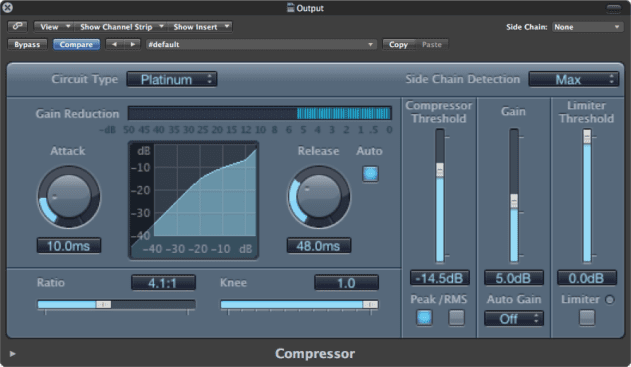
And with a soft knee:
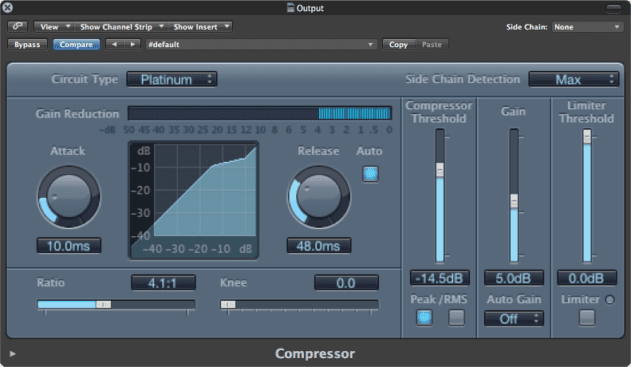
Different flavours
It’s also essential to realise that not all compressors are created equal. Do you ever wonder why successful engineers regularly use more than one type of compressor, or why certain models of compressor are favoured for particular scenarios, even in the software realm? Classic hardware including the SSL G Series master compressor, Neve 33609 and API 2500 (and, indeed, emulations of these and similar models) remain popular choices for mix compression despite apparently being somewhat limited in comparison to newer alternatives.
Much of the characteristic sound of these models is down to the different methods and components used to sense the input level, and then instigate the gain reduction process (taken care of by analysis in the sidechain).
Even many free options found in DAWs – such as Logic’s Platinum Compressor shown here – allow the user to dial in a range of alternative flavours, based on various traditional hardware designs. Notice the way that, even with the same settings, the sound and shape of the compression varies greatly.
First off, here’s a demo using the default Platinum mode. This is a fairly dull, slow model without much character:
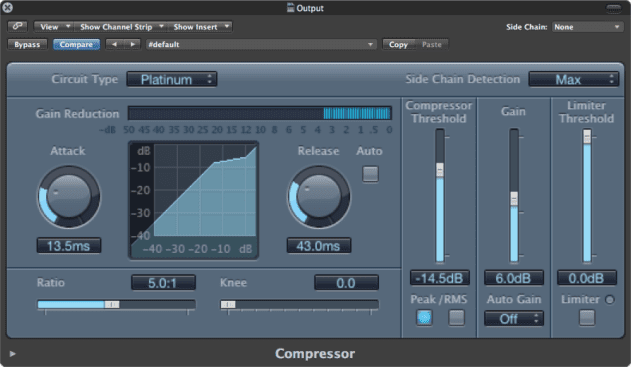
And then with the Opto mode, a very fast model based on classic optical compressors:
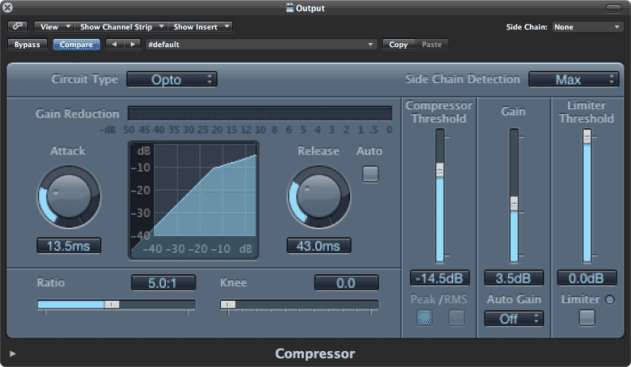
And finally VCA mode, with a coloured sound based on classic voltage-controlled attenuator circuits:
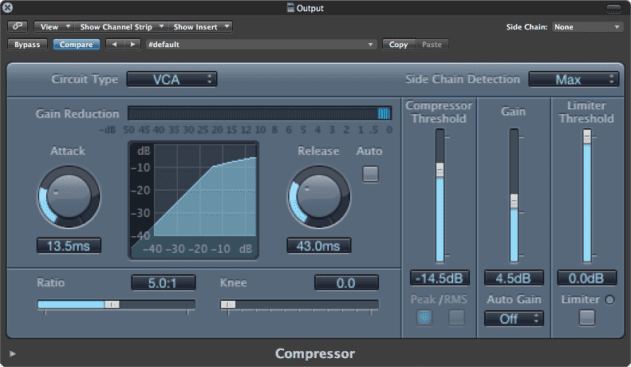
Increasingly, plugins are called on to emulate classic hardware units. In the case of mix bus compression, the most commonly emulated model is undoubtedly the SSL master compressor, used on countless great records. To many producers, the SSL is the sound of a hit record. Manufacturers including Universal Audio with their 4k Buss Compressor and Cytomic with The Glue have tried to capture this classic sound in software form.
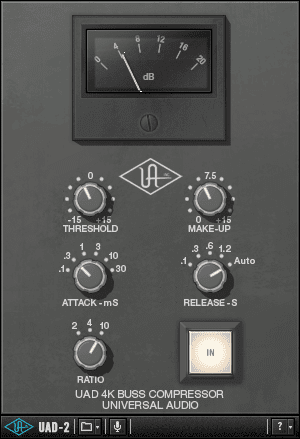
Compression vs Limiting
A discussion of mix bus compression would not be complete without a word on limiting – the process that has probably contributed more to the so-called loudness war than any other. Limiting is in fact just an extreme form of dynamic compression with a ratio of 10:1 or greater and (very) fast attack times.
We’ll explore limiters in detail another time, but bear in mind that while high ratio compression can massively boost the perceived loudness of your track, it can also add distortion to your mix, destroy dynamic range and create an incredibly fatiguing sound. For mix bus compression rather than out and out loudness, it’s best to stick to lower ratios (i.e. below 10:1) and ensure that attack times are slow enough not to destroy the dynamics of your mix.
For the time being, try experimenting with different types of moderate compression. Think colour and shape – not loudness – and you should be on the right lines.

12.30 AM
These walkthroughs are truly excellent and very helpful. Many more of the same please especially on EQ, Comp and Mix Tricks
08.15 PM
Nice read ..The understanding of Compression always brings me back to something I am not doing .. Self taught..Thanks
04.10 PM
This is very good stuff! Thanks for sharing!
07.36 PM
I LOVE THIS SITE. Truly! HIdden gem! Just a question – what is your opinion on adding limiting/compression to the master channel before beginning the track? Some advise doing it, others don’t …
09.26 AM
@MRSR
There are no rules here. As you say, some producers don’t do it, some are vocally anti it, and I would guess the majority probably do it. Of those who do it, some almost ‘mix to master’ – hitting the master processors hard to shape their sound – while I would say the majority use some processing – probably a bus-style compressor with some nice colouring EQ – but keep it subtle. This feels the best way to go; it gives the mastering engineer more space with which to work and it retains dynamics. But it depends hugely on what kind of music you make and the kind of sound you’re after.
Dave@Attack.
05.25 AM
Attack – following the above question – why would one even apply subtle bus-style compression and/or EQ on the master above leaving it completely clean?
Surely giving the mastering engineer the absolute maximum amount of latitude to do their work is preferable?
As I understand it, ANY master bus processing progressively limits the scope for mastering tweaks. Yet, you seem to suggest that the majority of producers utilize master bus compression to some extent.
05.25 AM
Also an installment in this series on Limiting would be ace.
09.53 AM
@ Citizen
Master bus compression is an aesthetic decision as well as a pragmatic one. Leaving the master bus completely untouched is an option, but (as a sweeping but reasonable generalisation) most producers prefer the gluing effect and mild loudening which comes from bus compression. If you’re happy with the mix as it is, there’s certainly no need to apply compression automatically, but in most cases it serves a useful purpose.
02.30 PM
just a quick observation, in the above hard/soft knee section…picture are inverted// soft knee should be the gentle curve
07.12 PM
Really Nice tutorial but I do have to take you to task on the awful attempt at dubstep on the bit about the modes on logic’s compressor. The rest of the music is well done but that sounded like one of those clips you hear on vst company’s page when they are trying to sex up a perfectly nice a VA synth as something “to make that music all the kids are listening to”. Some saw waves, an LFO, a filter and a distortion unit are simply not going to produce a wall of bass with dramatically changing timbres…It produces the sound of distorted filter sweeps.
Other than that I really like the feature…keep up the good work.
01.23 PM
Excellent cant wait to focus on this walk through certainly helped me out on EQ side mixes sound lot more pro now
03.34 PM
Hi, good how to, really interesting. I’ve a question for the author 🙂
When you say:
{ A compressor, at its most basic, is an automatic volume control whose operation is dependent on the level of the incoming signal. This means that the more sounds that are mixed together prior to its use, the more that any one sound in the mix can determine the compressor’s overall effect.
Low frequency material requires more energy to be heard – a greater movement of air needs to occur – and also tends to be mixed louder in dance music in order to achieve greater impact. As a result, the bass elements in a mix are most likely to push the compressor into action. }
You recommend to process the kickdrum separately from the other drum elements (like cymbals)? Because of the big difference of the compressor response to the signals (that are different in frequencies, low for the kick drum, high for cymbals)
04.09 AM
I think they got the knee wrong. Higher values are softer, and lower values are harder